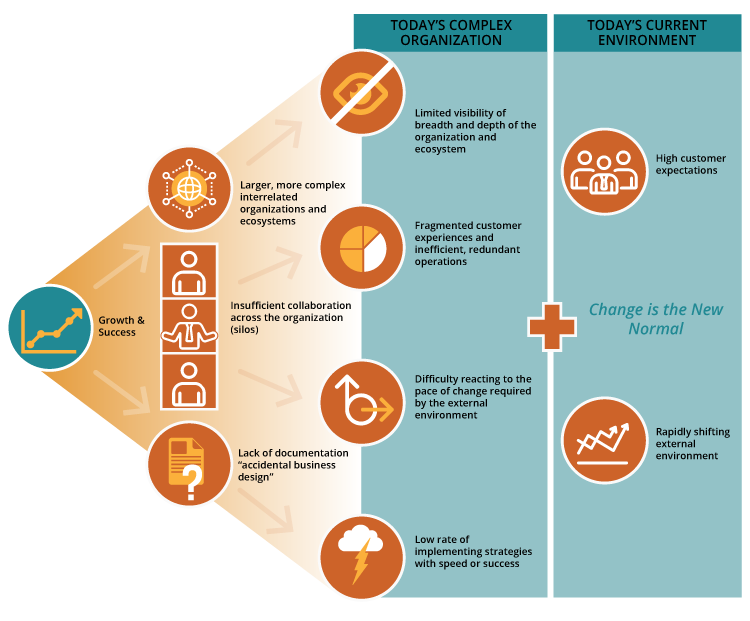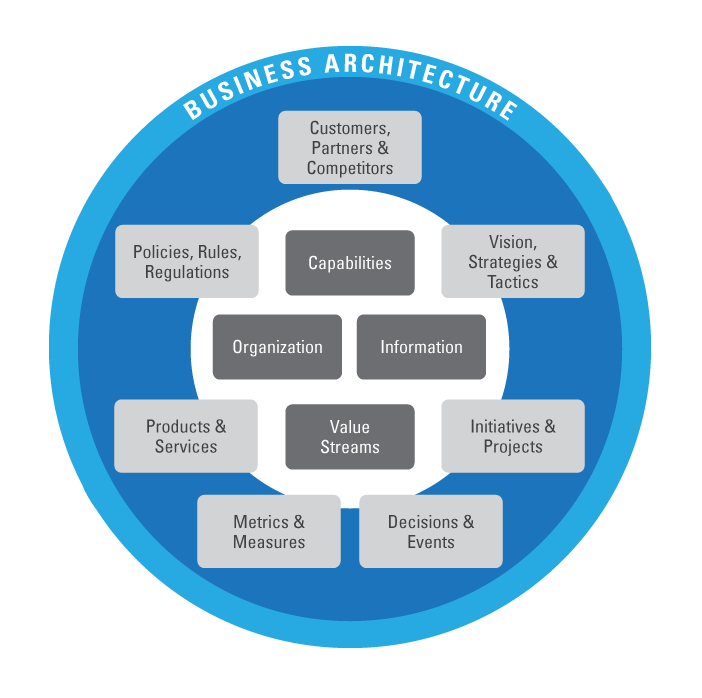Why should we do business architecture?
Good one. That’s the million-dollar question.
Simon Sinek says, “Start With Why.”
A big part of the answer is not just why business architecture is so important, but why it is so important now, so we’ll start there. A lot of people wonder how business architecture can be so great yet they haven’t heard of it until now, not to mention the fact that their organizations have been successful without it for decades. So here’s the “why now” explained in pictures.

The bottom line is that we work in complex organizations that are colliding with a world where constant change is the new normal. Organizations have finite resources, including time, people and funding, and the key is to focus those resources on the most important things in the most effective way. We need a new mindset for new results in order to survive and thrive. Enter business architecture as an important part of that shift.
Got it. But again, why should we do this?
Here’s one way to look at it. Let’s sum it up in three quick points, since we’re StraightTalkin’ here.
Number 1: Business Architecture Bridges Strategy and Execution
This is the big one. Probably the most important value business architecture provides is to facilitate change, especially because of that whole “why now” topic that we just covered. With business architecture (and IT architecture), we have an opportunity to shift the mindset by working top-down, with true enterprise collaboration—instead of in business unit silos. Using business architecture’s blueprint (and the talents of brilliant business architects) we can assess and catalog the impact all potential changes on the business and IT environment (from strategies, transformations, regulatory changes, etc.), and then collectively architect those changes and scope initiatives in the most effective way across business units. We can also make sure that the initiatives actually deliver on the objectives they were supposed to.
Number 2: Business Architecture Helps Simplify a Complex Environment
Remember how we talked about those complex environments? Business architecture helps identify opportunities for simplification in the business and IT environment using an enterprise business lens. Reducing complexity has its own benefits (e.g. cost savings), but idt also speeds up the pace at which an organization can implement change.
Number 3: Business Architecture Creates a Shared Language and Visibility
Numbers 1 and 2 are the biggies, so this one is a bonus. You know those conversations we all keep having in our organizations like about the definitions of “customer” and “product?” Business architecture can help. As you build and use your business architecture you create a common vocabulary and “mental model.” This makes conversations more effective and provides a bird’s eye view of what you do without all of the details.
So, if business architecture had a Six-Word Memoir, it might be something like:
Bridges strategy and execution; facilitates change.
Makes sense. So why is this so hard to explain to others?
Here’s the part where I tell you that you’re not crazy (or alone) for thinking that. There are a few reasons and knowing them helps.
- Business architecture is relatively “new” compared to functions and disciplines that have been around for decades. More time is required for education and adoption.
- Business architecture is not standalone; it makes other functions and disciplines more effective. It is never overlapping or competing when implemented properly.
- Business architecture introduces an enterprise mindset that challenges culture and behavior. Not everyone is a fan of collaborating across business units.
Give me some good news.
As the business architecture discipline continues to be practiced and as targeted industry efforts continue to permeate executive suites and the academic community, this will get easier. As understanding and acceptance grows, business architecture will eventually reach the level of recognition that other disciplines like project management and business analysis have now. And it will become just part of how we work, embedded into the fabric of our organizations.
In the meantime, think of yourself as part of a really cool movement.
Got it now.
Make 1-million dollar checks out to: s-t-r-a-i-g-h-t t-a-l-k.
For further reading —
The Value of Business Architecture (S2E White Paper, premium download): A longer and more formal version of this story on why business architecture is needed now as well as its value and usage.

